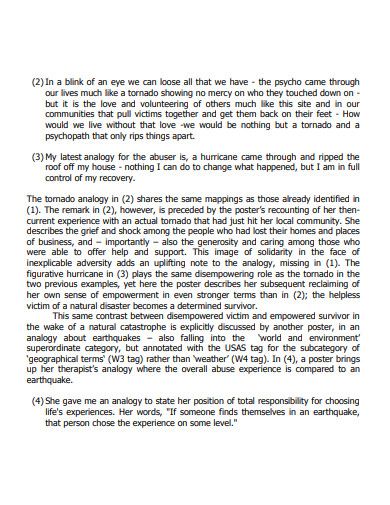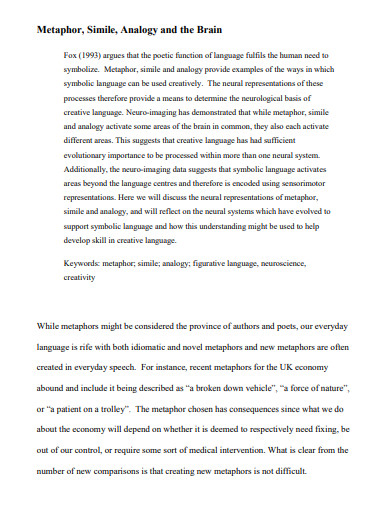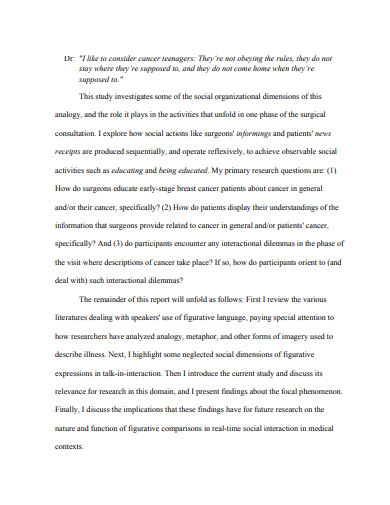5 Figurative Analogy Examples to Download
Basically, an analogy deals with comparing two things. It’s either you for their similarities or differences. They provide an explanation of something to give highlight of where they are exactly alike. There are different types of analogy. The literal analogy and the figurative analogy. We will explain the difference between the two on the later part of this article. As a review, an analogy is not a figure of speech. They are rhetorical devices that are used to provide arguments from sets of comparisons between two objects or two terms.
4+ Figurative Analogy Examples
1. Figurative Analogy Template
2. Figurative Language Analogy
3. Sample Figurative Analogy
4. Basic Figurative Analogy
5. Figurative Analogy Example
What is Figurative Analogy?
A figurative analogy is the comparison of two things that share common characteristics or properties. There are two types of figurative analogy: the simile and the metaphor. Just like literal analogy, a figurative analogy becomes weak during analogical reasoning.
Difference Between Figurative Analogy and Literal Analogy
In a literal analogy, you can say that one thing is similar to the other. This is the type of analogy that you would want to use when making an argument. Try to consider this example. When you are going to test something, the result should also be the same to the other variable. Whereas in figurative analogy, you compare two things that are not related to each other.
Importance of Analogy
Analogies make your ideas more specific. If encountered with difficult ideas, use analogies to make it easier for your readers to spot the difference. They also make the emotions of the texts visible for the readers by adding depth and feeling to the image presented.
Analogy can also be a tool used to persuade. This can be useful when you want to invalidate a flawed reasoning in someone else’s argument.
Example of Analogy in Literature
“Evolution is a blind giant who rolls a snowball down a hill. The ball is made of flakes—circumstances. They contribute to the mass without knowing it. They adhere without intention, and without foreseeing what is to result. When they see the result they marvel at the monster ball and wonder how the contriving of it came to be originally thought out and planned. Whereas there was no such planning, there was only a law: the ball once started, all the circumstances that happened to lie in its path would help to build it, in spite of themselves.”
– Mark Twain, Tales of Wonder
Example of Analogy in Pop Culture
“People are like stained-glass windows. They sparkle and shine when the sun is out, but when the darkness sets in, their true beauty is revealed only if there is a light from within.”
– Quote by Elisabeth Kübler-Ross in The Leader’s Digest by Jim Clemmer, 2003
Examples of Analogy in Speech and Writing
- Finding a good man is like finding a needle in a haystack: As Dusty Springfield knows, finding a small needle in a pile of hay takes a long time, so the task at hand is likely to be hard and tedious.
- That movie was a roller coaster ride of emotions: While you’re not flying through the air, the twists, turns and surprises of a movie plot can leave you feeling like you’ve been through quite an experience.
- That’s as useful as rearranging deck chairs on the Titanic: It looks like you’re doing something helpful but really it will make no difference in the end.
examples.yourdictionary.com
FAQs
Where do we use analogy?
We use analogies when we compare terms, objects or anything to another.
Is figurative analogy a figure of speech?
These type of analogy is not a figure of speech. They are rhetorical devices.
Why is it important to use analogy in your life?
Analogies develop strategies that help understand the relationship between the two terms, objects or situation.
There is a difference between a literal analogy and a figurative analogy where both of them are considered as tools to compare different objects, situation and terms. You just have to be specific nd be able to present an image for the convenience of the readers and to help them understand it easily. We can use analogy in different ways. It may be in a form of literature, pop culture or in speech and writing.







